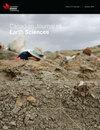东昆仑造山带晚三叠世基性微包体花岗岩:岩石成因及其陆壳演化和地球动力学演化意义
IF 1.6
4区 地球科学
Q3 GEOSCIENCES, MULTIDISCIPLINARY
引用次数: 0
摘要
东昆仑造山带晚三叠世花岗岩的岩浆来源存在争议,制约了我们对东昆仑造山带地壳演化和地球动力学演化的认识。为此,本研究通过长石和角闪洞锆石U-Pb同位素定年、主量和痕量地球化学分析、电子探针分析(EMPA)和原位锆石Hf同位素分析,揭示了相日勒寄主花岗岩及其基性微颗粒包体(MMEs)的岩浆来源及其地球动力学意义。锆石U-Pb测年结果表明,相日勒岩体与MMEs在228 ~ 223 Ma同时结晶。与寄主花岗岩相比,MMEs具有火成岩的结构、更细的粒度、更高的结晶温度和含水量以及更低的氧逸度,表明它们可能来自两个不同的原始岩浆。因此,MMEs被认为是花岗质岩浆与基性岩浆混合作用的产物。相日勒寄主花岗岩具有较高的Sr/Y(42.0 ~ 73.1)和La/Yb)N(12.7 ~ 30.7)比值,与下地壳增厚的埃达岩具有亲缘关系。结合同时期基性岩的εHf(t)值(−3.47 ~ +0.08),认为它们是由幼体增厚下地壳部分熔融形成的。相日勒寄主花岗岩和广泛分布的同年代花岗岩的阿达质特征表明,228 Ma以前存在下地壳增厚,下岩石圈的拆沉可能是导致碰撞后伸展的地球动力学过程。本文章由计算机程序翻译,如有差异,请以英文原文为准。
Late Triassic granites with mafic microenclaves in the East Kunlun Orogenic Belt, northwestern China: Petrogenesis and implications for continental crust evolution and geodynamic evolution
The magmatic source of the Late Triassic granites in the East Kunlun Orogenic Belt (EKOB) is controversial, which restricts our understanding of crustal evolution and geodynamic evolution in the EKOB. Therefore, this study conducts zircon U‒Pb isotope dating, major and trace geochemical analysis, electron microprobe analysis (EMPA) of feldspar and amphibole, and in-situ zircon Hf isotope analysis of Xiangride host granites and their mafic microgranular enclaves (MMEs) in the EKOB to reveal their magmatic source and geodynamic implications. Zircon U‒Pb dating shows that the Xiangride host granites and the MMEs crystallized simultaneously at ca. 228-223 Ma. The MMEs show an igneous texture, finer grain size, higher crystallization temperature and water content, and lower oxygen fugacity than those of the host granite, suggesting that they were probably derived from two distinct primitive magmas. Therefore, the MMEs are considered the products of magma mixing between granitic and mafic magmas. The Xiangride host granites show high Sr/Y (42.0-73.1) and (La/Yb)N (12.7 to 30.7) ratios, showing affinity with adakites derived from a thickened lower crust. Combined with the indistinguishable εHf(t) values (−3.47 to +0.08) from the coeval mafic rocks, it is concluded that they are derived from partial melting of juvenile thickened lower crust. The adakitic features of the Xiangride host granites and widespread coeval granites indicate the existence of a thickened lower crust before 228 Ma and delamination of the lower lithosphere is likely the geodynamic process resulting in the postcollisional extension regime.
求助全文
通过发布文献求助,成功后即可免费获取论文全文。
去求助
来源期刊

Canadian Journal of Earth Sciences
地学-地球科学综合
CiteScore
2.80
自引率
7.10%
发文量
66
审稿时长
6-12 weeks
期刊介绍:
The Canadian Journal of Earth Sciences reports current research in climate and environmental geoscience; geoarchaeology and forensic geoscience; geochronology and geochemistry; geophysics; GIS and geomatics; hydrology; mineralogy and petrology; mining and engineering geology; ore deposits and economic geology; paleontology, petroleum geology and basin analysis; physical geography and Quaternary geoscience; planetary geoscience; sedimentology and stratigraphy; soil sciences; and structural geology and tectonics. It also publishes special issues that focus on information and studies about a particular segment of earth sciences.
 求助内容:
求助内容: 应助结果提醒方式:
应助结果提醒方式:


